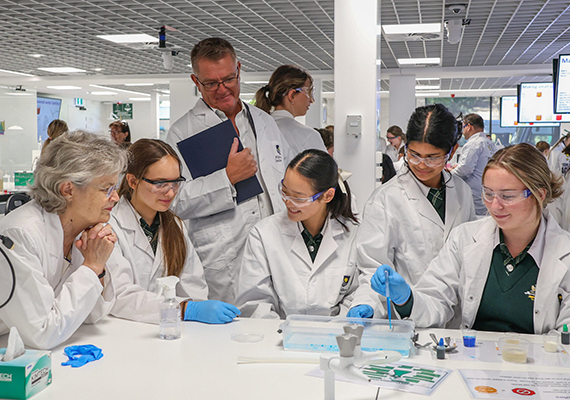
Building the numbers of female scientists begins with inspiring more young girls to pursue scientific studies, which is why Flinders University has developed the STEM Enrichment Academy.
Created in 2019, the program recognises the underrepresentation of women and girls in STEM – the study of Science, Technology, Engineering and Mathematics. Led by Flinders University Professor of Physics Maria Parappilly, the STEM Enrichment Academy offers intensive hands-on experience with science topics through visits to Flinders University, and has so far inspired more than 1600 female Year 9 students.
“The core aim is to encourage young women to consider future STEM careers and inspire them to pursue STEM subjects, particularly at a critical moment when they are making subject selections at senior school level,” explains Professor Parappilly.
“The big difference is that our Enrichment Academy provides hands-on experience inside the laboratory – not just online theory courses, but something tangible that excites and inspires the students to investigate science.”
This strong impression has been bolstered by the recent $7 million redevelopment of major laboratories and resources in the College of Science and Engineering at Flinders’ Bedford Park campus, which will also benefit school students’ learning through a variety of STEM outreach activities delivered in these labs.
“Introducing the girls to this sort of study environment brings to life many of the practical and fundamental parts of science to inspire them,” says Professor Parappilly.
As a result, schools that have participated in the STEM Enrichment Academy now have STEM subject enrolment rates well above the national average for girls. Since the program’s inception, 91% of the Year 9 participants have developed an interest in STEM after the program. This includes 330 regional students and 32 Indigenous students who have had access to the program since 2023. Of the 2019 cohort, university enrolments amongst followed-up girls showed a wide range of STEM degrees, including physics. These numbers have exceeded the project target for regional girls by more than four times.
The program’s innovative approach of flying in regional students and teachers for three-day enrichment sessions addressed the lack of resources and other barriers faced by these underrepresented groups.
“Just placing this attention on girls from these remote areas has made a massive difference. Girls who had considered dropping out of school came to the Academy, got inspired and are now leaders in their school science lab. We have seen incredible turnarounds,” says Professor Parappilly.

Maths and science teacher Dolina Dyson from Taminmin College in Darwin, a large secondary college that has almost 50% of its students from a disadvantaged background, says participating in the Enrichment Academy had an immediate effect on her students.
“In 2025, there are more Year 10 girls engaged in curriculum and mainstream STEM subjects. They see pathways forward and look for more relevance in their courses, to determine their post-Year 10 pathway,” says Ms Dyson.
The Academy has also supported 263 teachers from 60 schools, through the introduction of a Physics Skills Enhancement Microcredential Course to bolster teachers’ presentation of STEM subjects in class, which is being offered to teachers around Australia.
The course even went over capacity for the August 2025 intake, with teachers enrolling from all across Australia, including including regions like Eastern Pilbara, Broome and Margaret River.
The Academy has been able to identify the enablers and barriers for girls entering STEM fields and evaluate the positive impact of STEM programs. It also identified particular needs of girls at schools outside of major cities, which is why the STEM Enrichment Academy has expanded since 2023 to include regional students from South Australia and the Northern Territory.
“These regional schools felt as though they had been left behind, but Flinders has the capability to engage girls in STEM from regional and remote areas,” says Professor Parappilly.
“We are upskilling teachers at the same time as we are inspiring young students, and it is vitally important that both these things happen together.
“We aim to inspire teachers about how best to inspire their students – and this has included Dr Ken Silburn from New South Wales, who received the Prime Minister’s Prize for Science – Secondary teaching.”
Many of the initial girls who participated in the STEM Enrichment Academy are now at university and pursuing degrees. This includes Victoria Rowe, who is currently studying Nuclear Engineering at Flinders University and visited Rhode Island University in the United States during 2025, as part of a 15-week study exchange program.
“It’s very exciting that we will soon have alumni that have been a part of the Enrichment Academy,” says Professor Parappilly.
“Those girls will be the role models to the younger students coming to the Academy, as the living proof of what can also lay ahead for girls who pursue STEM studies.”

